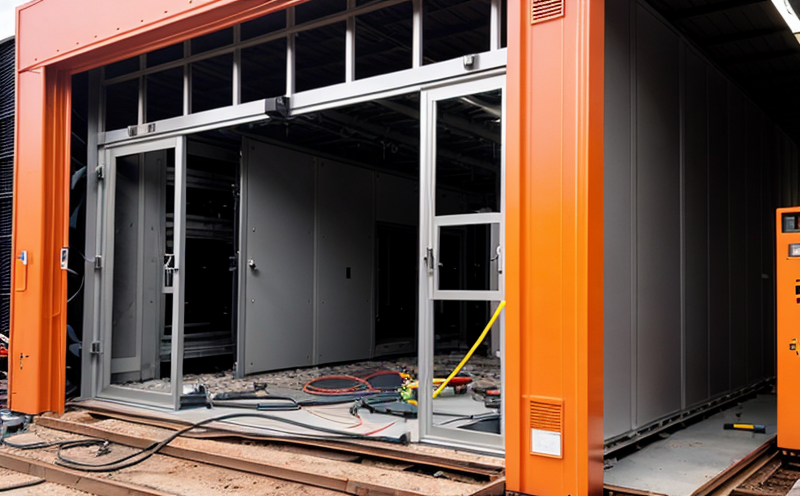BS EN 50342 Thermal and Safety Testing of Automotive Lead-Acid Batteries
The BS EN 50342 standard provides a comprehensive framework for testing automotive lead-acid batteries, focusing on thermal management and safety. This standard ensures that the battery performs safely under various environmental conditions, which is critical in preventing potential hazards such as overheating or electrical shorts.
Thermal stress can significantly impact the performance and lifespan of automotive lead-acid batteries. Compliance with BS EN 50342 helps manufacturers ensure their products meet stringent safety requirements, thereby reducing the risk of accidents on the road. This standard is particularly relevant for electric vehicles (EVs), where battery thermal management plays a crucial role in overall vehicle safety.
The testing process involves placing the battery under controlled conditions to simulate real-world scenarios. For instance, the battery may be subjected to high temperatures or low temperatures while being monitored for temperature fluctuations and voltage changes. The standard specifies that these tests must be conducted within specified limits to ensure the integrity of the battery.
One of the key aspects of this testing is the measurement of thermal resistance, which helps determine how well the battery can dissipate heat. This is crucial in preventing overheating, a common issue that can lead to reduced battery performance and increased risk of fire or explosion. The standard also covers the evaluation of battery terminals and connectors to ensure they are not prone to melting under extreme conditions.
Another important aspect of thermal testing is the assessment of the battery's ability to withstand short-circuiting. This test evaluates how quickly the battery can recover from a short circuit, ensuring that it does not sustain permanent damage. The standard specifies that the battery must be able to resume normal operation within a certain time frame after a short circuit.
The BS EN 50342 standard also addresses the issue of battery leakage, which is particularly relevant for automotive applications where the battery is in close proximity to sensitive electronic components. Leakage can lead to corrosion and other issues that can affect the overall performance of the vehicle. The standard requires that batteries pass a leak test before being certified as compliant.
In addition to thermal testing, the standard also covers electrical safety tests, including overcharging and overdischarging tests. These tests are designed to ensure that the battery does not exceed its design limits, which can lead to failures or hazards. The standard specifies that batteries must be able to withstand these conditions without sustaining permanent damage.
The BS EN 50342 standard is widely used in the automotive industry and is recognized by regulatory bodies around the world. Compliance with this standard ensures that manufacturers meet the highest safety standards, which can help them gain a competitive edge in the market. By ensuring that their products meet these stringent requirements, manufacturers can enhance customer confidence and reduce the risk of accidents on the road.
The testing process for BS EN 50342 involves several steps, including preparation of the test specimen, setting up the test environment, conducting the tests, and analyzing the results. The specimen is typically a fully charged automotive lead-acid battery that has been preconditioned to ensure consistency in the testing process.
The test environment must be controlled to simulate real-world conditions as closely as possible. This may involve using temperature chambers or other equipment to create specific environmental conditions. The tests are conducted under these controlled conditions, and the results are carefully recorded for analysis.
Once the tests are complete, the results are analyzed to determine whether the battery meets the requirements of the standard. If the battery fails any of the tests, it is considered non-compliant with BS EN 50342. Non-compliance may lead to rejection of the product by the manufacturer or regulatory authorities.
Compliance with BS EN 50342 can provide several benefits for manufacturers and consumers alike. For manufacturers, compliance helps ensure that their products meet the highest safety standards, which can enhance customer confidence and reduce the risk of accidents on the road. For consumers, compliance ensures that they are purchasing a safe product that meets the latest industry standards.
Benefits
- Ensures compliance with international safety standards
- Enhances customer confidence in product quality and safety
- Promotes safer automotive systems by reducing the risk of battery-related accidents
- Provides a competitive advantage through adherence to best practices
- Facilitates smoother regulatory approval processes
- Reduces liability risks associated with non-compliance
- Simplifies product design and certification for international markets
Customer Impact and Satisfaction
- Better safety features leading to increased customer satisfaction
- Enhanced trust in the brand due to proven compliance with rigorous standards
- Improved reliability of automotive systems contributing to greater customer satisfaction
- Increased product lifespan and performance, resulting in cost savings for customers
- Faster resolution times for any issues arising from non-compliance
- Prompter response to market demands by adhering to the latest safety protocols





